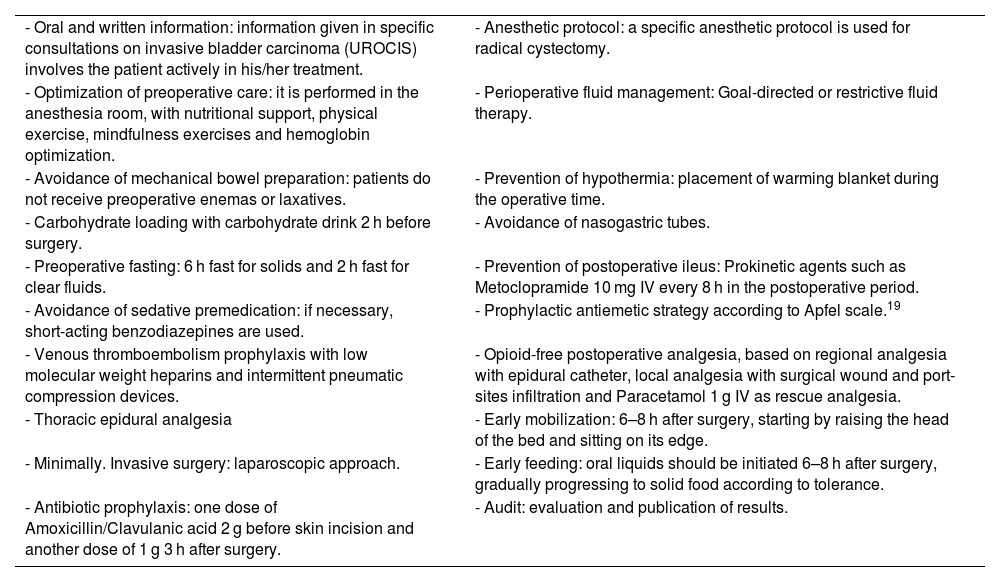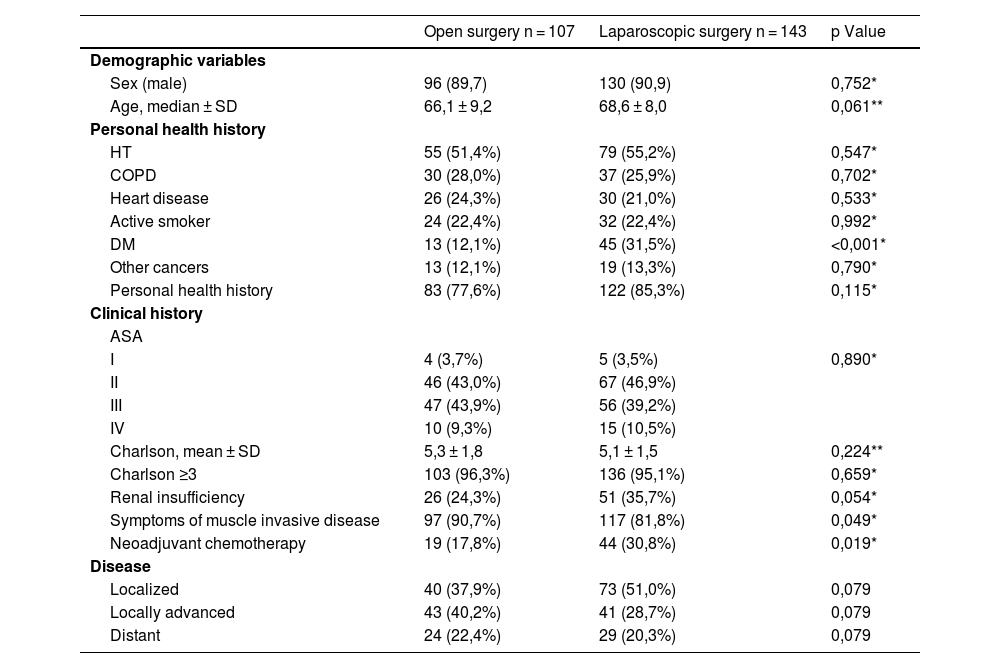The implementation of Enhanced Recover After Surgery (ERAS) multimodal rehabilitation protocols in radical cystectomy has shown to improve outcomes in hospital stay and complications. The aim of this analysis is to evaluate the impact of laparoscopic surgery on radical cystectomy within a multimodal rehabilitation program.
Material and methodsThe study was carried out in a third level center between 2011 and 2020 including patients with bladder cancer submitted to radical cystectomy according to an ERAS (Enhanced Recovery After Surgery) protocol and the Spanish Multimodal Rehabilitation Group (GERM) with 20 items to be fulfilled.
ResultsA total of 250 radical cystectomies were performed throughout the study period, 42.8% by open surgery (OS) and 57.2% by laparoscopic surgery (LS). The groups are comparable in demographic and clinical variables (p > 0.05).
Operative time was longer in the LS group (248.4 ± 55.0 vs. 286.2 ± 51.9 min; p < 0.001). However, bleeding was significantly lower in the LS group (417.5 ± 365.7 vs. 877.9 ± 529.7 cc; p < 0.001), as was the need for blood transfusion (33.6% vs. 58.9%; p < 0.001). Postoperative length of stay (11.5 ± 10.5 vs. 20.1 ± 17.2 days; p < 0.001), total and major complications were also significantly lower in this group (LS). The readmission rate was lower in the LS group but not significantly (36.4% vs. 29.4%; p = 0.237). The difference between 90-day mortality in both groups was not statistically significant (2.8% LS vs. 4.3% OS; p = 0.546). The differences were maintained in the multivariate models.
ConclusionsLaparoscopic surgery within a multimodal rehabilitation program increases operative time but significantly decreases intraoperative bleeding, transfusion requirements, postoperative length of stay, and complications.
Los protocolos de rehabilitación multimodal ERAS en cistectomía radical han demostrado ser útiles para mejorar los resultados en la estancia hospitalaria y las complicaciones. El objetivo de este análisis es evaluar el impacto de la cirugía laparoscópica (CL) dentro de un programa de rehabilitación multimodal.
Material y métodosSe incluyeron en el estudio los pacientes intervenidos de cistectomía radical por cáncer vesical en un centro de tercer nivel, entre los años 2011 y 2020, según el protocolo Enhanced Recovery After Surgery (ERAS) y el Grupo Español de Rehabilitación Multimodal (GERM) con 20 ítems a cumplir.
ResultadosSe realizaron 250 cistectomías radicales durante el periodo de estudio, el 42,8% cirugía abierta (CA) y el 57,2% CL. Los grupos son comparables para las principales variables demográficas y clínicas (p > 0,05).El tiempo quirúrgico es mayor en el grupo de CL (248,4 ± 55,0 vs. 286,2 ± 51,9 min; p < 0,001). Sin embargo, el sangrado es significativamente menor en CL (417,5 ± 365,7 vs. 877,9 ± 529,7 cc; p < 0,001), así como la necesidad de transfusión (33,6 vs. 58,9%; p < 0,001). También es significativamente menor en este grupo (CL) la estancia postoperatoria (11,5 ± 10,5 vs. 20,1 ± 17,2 días; p < 0,001), y las complicaciones totales y mayores. La tasa de reingresos fue menor en el grupo de CL, pero no de forma significativa (36,4 vs. 29,4%; p = 0,237). La diferencia entre mortalidad a 90 días de ambos grupos no resulta estadísticamente significativa (2,8 CL vs. 4,3% CA; p = 0,546). Las diferencias se mantienen en los modelos multivariantes.
ConclusionesLa CL, dentro de un programa de rehabilitación multimodal, aumenta el tiempo quirúrgico, pero disminuye significativamente el sangrado intraoperatorio, la necesidad de transfusión, la estancia postoperatoria y las complicaciones.










